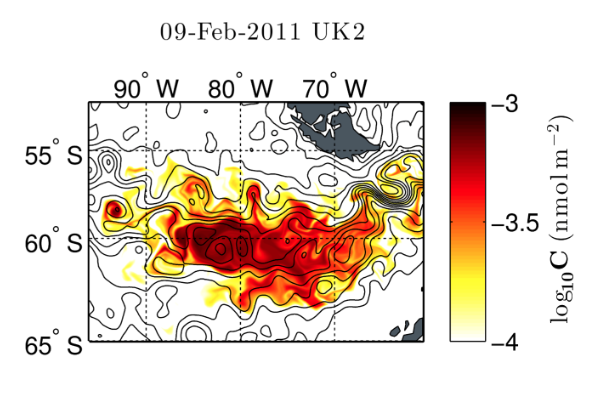story by Helen Hill [1]
British Antarctic Survey oceanographers Emma Boland, and longtime MITgcm user Emily Shuckburgh, together with co-authors, have been using the MITgcm to help understand the role of turbulent mixing in the Antarctic as part of the Diapycnal and Isopycnal Mixing Experiment in the Southern Ocean (DIMES.)
An understanding of long-term climate change is intimately linked with an understanding of the Southern Ocean circulation but searching for that understanding ocean modelers quickly find themselves up against a hard truth: Getting the circulation right requires getting both the sub-mesoscale mixing and turbulence just right.
The Diapycnal and Isopycnal Mixing Experiment in the Southern Ocean (DIMES) was initiated in 2009, with an aim to quantify the role of small- and large-scale turbulent mixing in the Antarctic Circumpolar Current (ACC). The DIMES field program has focused on the part of the ACC that flows from the abyssal plain in the southeastern Pacific into the topographically rough Drake Passage region and beyond.
In Estimating a sub-mesoscale diffusivity using a roughness measure applied to a tracer release experiment in the Southern Ocean (to be released as part of JPO’s upcoming The Diapycnal and Isopycnal Mixing Experiment in the Southern Ocean (DIMES) Special Collection, Emma Boland working with long-time MITgcm user Emily Shuckburgh at British Antarctic Survey and co-authors, have been using MITgcm to test the use of a measure to diagnose a sub-mesoscale isopycnal diffusivity by determining the best match between observations of a tracer and simulations with varying small-scale diffusivities.
Specifically, the team set out to investigate the robustness of a ‘roughness’ measure to discriminate between tracer fields experiencing different sub-mesoscale isopycnal diffusivities advected by scaled altimetric velocity fields.
Boland et al. use their measure to compare numerical simulations of the tracer released at a depth of about 1.5 km in the Pacific sector of the Southern Ocean during the DIMES field campaign with observations of the tracer taken on DIMES cruises.
 [3]
[3]Emma Boland has been using MITgcm since 2010. When she’s not modelling the ocean, she enjoys knitting and running after her one-year old.
The team find that simulations with an isopycnal diffusivity of ~20 m2s−1 best match observations in the Pacific sector of the ACC, rising to ~20-50 m2s−1 through Drake Passage, representing sub-mesoscale processes and any mesoscale processes unresolved by the advecting altimetry fields. In addition, except where there are simply too few measurements overall, they demonstrate that the roughness measure is a statistically robust way to estimate a small-scale diffusivity when measurements are relatively sparse in space and time. They also consider how planning of tracer measurements during a cruise in order to maximise the robustness of the roughness measure might be important finding that the role of the roughness measure becomes more robust if the spatial resolution of tracer measurements is increased with the time since tracer release.
To find out more about this work contact Emma [4].
This Month’s Featured Publication
- Emma J. D. Boland, Emily Shuckburgh, Peter H. Haynes, James R. Ledwell, Marie-José Messias, and Andrew J. Watson (2015), Estimating a sub-mesoscale diffusivity using a roughness measure applied to a tracer release experiment in the Southern Ocean, Journal of Physical Oceanography, e-view, doi: 10.1175/JPO-D-14-0047.1 [5]
Other New Publications this Month
Tina Dippe, Xiaoming Zhai, Richard J. Greatbatch, and Willi Rath (2015), Interannual variability of wind power input to near-inertial motions in the North Atlantic, Ocean Dynamics (accepted), doi: 10.1007/s10236-015-0834-x [6]
Helen S. Findlay, Georgina Gibson, Monika Kędra, Nathalie Morata, Monika Orchowska, Alexey K. Pavlov, Marit Reigstad, Anna Silyakova, Jean-Éric Tremblay, Waldemar Walczowski, Agata Weydmann, and Christie Logvinova (2015), Responses in Arctic marine carbon cycle processes: conceptual scenarios and implications for ecosystem function, Polar Research 2015, 34, 24252, doi: 10.3402/polar.v34.24252 [7]
M. M. Flexas, M. P. Schodlok, L. Padman, D. Menemenlis, and A. H. Orsi (2015), Role of tides on the formation of the Antarctic Slope Front at the Weddell-Scotia Confluence, Journal of Geophysical Research Oceans (accepted), doi: 10.1002/2014JC010372 [8]
Peter Köhler, Christoph Völker, Gregor Knorr, and Edouard Bard (2015), High Latitude Impacts on Deglacial CO2: Southern Ocean Westerly Winds and Northern Hemisphere Permafrost Thawing, Nova Acta Leopoldina NF 121, Nr. 408, 135 –140 (2015), pdf [9]
Taira Nagai and Toshiyuki Hibiya (2015), Internal tides and associated vertical mixing in the Indonesian Archipelago, Journal of Geophysical research Oceans (accepted manuscript), doi: 10.1002/2014JC010592 [10]
Lars Nerger and Paul Kirchgessner (2015), Building Ensemble-Based Data Assimilation Systems, (pdf [11])
Andy Pickering, Matthew Alford, Jonathan Nash, Luc Rainville, Maarten Buijsman, Dong Shan Ko, and Byungho Lim (2015), Structure and Variability of Internal Tides in Luzon Strait, Journal of Physical Oceanography; e-view, doi: 10.1175/JPO-D-14-0250.1 [12]
V. Schourup-Kristensen, J. Hauck, M. Losch, D. A. Wolf-Gladrow, and C. Völker (2015), Iron supply to the Southern Ocean mixed layer from below; the ocean model effect pdf [13]
A.L. Stewart, and A.F. Thompson (2015), The Neutral Density Temporal Residual Mean overturning circulation, Ocean Modelling (in press), doi: 10.1016/j.ocemod.2015.03.005 [14]
Mohamed Wahib and Naoya Maruyama (2015), Automated GPU Kernel Transformations in Large-Scale Production Stencil Applications, HPDC’15 [15], June 15-19, 2015, Portland, Oregon, USA, pdf [16]
Christopher L. Wolfe and Paola Cessi (2015), Multiple regimes and low-frequency variability in the quasi-adiabatic overturning circulation, Journal of Physical Oceanography (e-view), doi: 10.1175/JPO-D-14-0095.1 [17]
Tingting Yang and Yongsheng Xu (2015), Estimation of the time series of the meridional heat transport across 15°N in the Pacific Ocean from Argo and satellite data, Journal of Geophysical Research Oceans (early online view), doi: 10.1002/2015JC010752 [18]
Q. Yang, M. Losch, S. Losa, T. Jung, L. Nerger, and T. Lavergne (2015), The benefit of using sea ice concentration satellite data products with uncertainty estimates in summer sea ice data assimilation, The Cryosphere Discuss., 9, 2543–2562, 2015, doi: 10.5194/tcd-9-2543-2015 [19]
Do you have news about research using MITgcm? We are looking for contributions to these pages. If you have an interesting MITgcm project (ocean, atmosphere, sea-ice, physics, biology or otherwise) that you want to tell people about, get in touch. To make a post, contact Helen [20]
